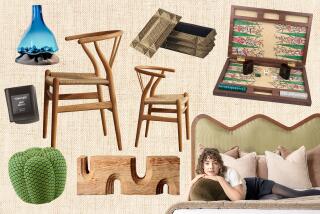Delights From a Fanciful Danish Designer
COPENHAGEN â --Danish design conjures up images of the sleekly modern, elegantly simple shapes and advanced mechanical elements that are on the cutting edge of high tech.
Those expectations are met along Copenhagenâs famous pedestrians-only shopping street, the Stroget, where shop windows display the most modern models of Danish furniture, home and personal accessories, and electronics and fashion.
But high tech and modern are not the only elements in todayâs Danish design. A designer shop just off the Stroget at 11 Ny Ostegade looks as if it might have been lifted from the pages of an illustrated edition of âThe Arabian Nights.â The shop belongs to one of Denmarkâs most famous and highly respected contemporary designers, Bjorn Wiinblads.
The unusual style of Bjorn Wiinblads Hus and its wares is unexpected, individualistic and intriguing, especially in contrast to neighboring shops that feature the latest in Danish minimalist modern design. The shop is filled with fanciful and ornate home decorating items that in a way comprise the filigree and gingerbread elements of Danish design.
Fanciful and Functional
Wiinblads designs and makes objects of ceramic and porcelain-- fanciful and functional expressions of the artistâs imagination. They take the shape of a charming entourage of amusing, cheerful and colorful creatures: princes, princesses, pashas, veiled ladies, handsome youths, idyllic maidens, elephants and other animals.
There are sculptures of ceramic clay, some three or four feet tall; others are diminutive enough to serve as candle holders, vases and centerpieces. The figures have round, wide-eyed faces and pixilated smiles. Their clothing and pedestals are decorated with floral designs and geometric patterns, often reminiscent of backgrounds in Persian miniatures.
Wiinblads uses drawings of his characters to adorn tiles, table service, drinking glasses, pitchers, fabrics, tapestries, posters and other items for decorating the home.
The shop is an elegant little house, with Wiinblads creations displayed throughout its rooms and levels.
There are many one-of-a-kind objects, including elaborate tiled fountains built into patios bedecked with large Wiinblads planters. The babbling of constantly recycled water provides relaxing background music.
Like a Storybook
The shop exemplifies Wiinbladsâ philosophy that functional things should add beauty and pleasure to the lives of those who use them. Every corner of the place is as enchanting as a storybook.
Wiinblads acknowledges that he has been very much influenced by literature. He comes from a family of writers and journalists and has written successful childrenâs books. Many of his themes for designing items as diverse as tableware and bed linens have been taken from literary sources, including âThe Arabian Nights,â âThe Magic Fluteâ and âA Midsummer Nightâs Dream,â among others.
Wiinbladsâ ceramics are sold in selected stores in Copenhagen (including Illums Bolighus and Den Permanente) and around the world, but no retail collection is as comprehensive and well-coordinated as that in Bjorn Wiinblads Hus.
The staff is accommodating and helpful. You also have a chance of meeting Bjorn Wiinblads, who often drops in at the shop to rearrange and update the display and chat with customers. He is every bit as witty and charming as his products.
Wiinblads painted his first porcelain pieces when he was 10 or 11 years old. His first exhibition was held during the final months of World War II and his imaginative, cheerful and individualistic designs made him an overnight success.
As borders across Europe were reopened, Wiinblads was invited to exhibit elsewhere. He was working in heavy ceramics decorated with an array of bold colors.
Palette Has Changed
In 1946 he began a 10-year collaboration with a small faience factory called Nymolle. His designs for tableware included one-color, fine-line drawings. Some of those designs are still in production. Wiinbladsâ palette has changed many times, but his style has always employed the fabulous cast of imaginary characters that are his trademark.
In 1957 Wiinblads began working with Rosenthal, the German porcelain and glass factory. The varied designs for Rosenthal have included a porcelain âMagic Fluteâ series and a âTil Eulenspiegelâ series in ceramics, as well as the well-known âRomanceâ and âLotusâ series, each of which has specially shaped plates, bowls and servers, and the lovely âTulipaâ candlesticks. Wiinblads also designs Rosenthalâs famous annual porcelain Christmas plates.
Wiinblads works with both Rosenthal and Nymolle. In addition, he has a workshop in Copenhagen, where he develops ideas and products. One-of-a-kind pieces sold in Bjorn Wiinblads Hus originate in the workshop. Wiinblads accepts commissions for special projects, including dinnerware for royalty, design fabrics for textile factories and tapestries that are executed by Portuguese weavers.
But not all the designs are exclusive and expensive. Wiinblads creates wrapping paper, boxes, puzzles and toys for Irma, a chain of inexpensive Danish supermarkets. He has made examples of his art widely available to people with limited budgets. Other designers followed, and now ordinary Irma shopping bags are decorated by leading artists, architects and designers, and are considered collectibles.
Bjorn Wiinblads Hus features Rosenthal and Nymolle lines, and is the only outlet for Wiinbladsâ workshop items. Prices of factory-produced wares are standardized, but there is an 18% tax rebate for Americans buying in Copenhagen.
Price List
For example, the shop sells the 1975 Rosenthal Christmas plate for $275 (with tax rebate, $225.50). A set of four blue and white figurines entitled âThe Four Seasonsâ costs $1,200 ($984 with tax rebate). A large fountain/statue is $18,000 ($14,760 with rebate). Six-by-six-inch tiles cost $9 each. Brass candlesticks are $190 each ($156 with rebate). A three-piece bed linen set (sheet, blanket cover and pillow case) costs $80 ($66 with rebate). Greeting cards cost from 55 cents to $4 each, posters from $20 up.
Browsing is, of course, free. And the experience of being in this delightful environment and, perhaps, of meeting Wiinblads, is priceless.
Prices quoted reflect currency exchange rates at time of writing.
More to Read
Sign up for The Wild
Weâll help you find the best places to hike, bike and run, as well as the perfect silent spots for meditation and yoga.
You may occasionally receive promotional content from the Los Angeles Times.






